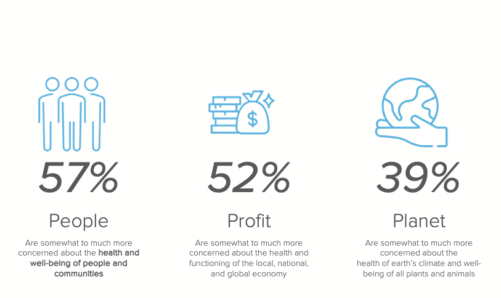IAQ Is the Next Big Deal
Shelton Stat of the Week
18% of Americans are more concerned about indoor air quality than before the pandemic, Mini Pulse, May, 2020
My headline may seem like a bit of a “no duh.” We’re in a pandemic fueled by an airborne virus, after all. And I’ve previously written about the likely impacts of Coronavirus on concerns about the air we’re breathing in our homes and buildings.
Today, I’d like to put a little data behind it, from our latest polling, completed in May.
Let’s go back in time, first:
- Pre-pandemic, health was becoming a primary driver for home improvement. (I’ve written a lot about this as well and preached from my soapbox repeatedly about shutting down all the “save money” messaging for energy efficiency marketing in favor of “breathe easier” messaging.)
- 72% of Americans believed their homes had a moderate to strong impact on their health.
- 60% were at least somewhat concerned about indoor air quality (IAQ).
- 51% said it was important to upgrade their ventilation systems to improve indoor air quality.
- We also identified a subgroup of Americans – 25% of the population – as Healthy Home Believers, folks highly activated on making their homes healthier (profiled here).
Today, 64% of us remain as concerned about indoor air quality as we were before – and the “before” was 60% of us – and 18% of us are more concerned about indoor air quality. The data sets from last year and this year are a bit apples-to-oranges since we asked the questions differently, but you could draw a solid conclusion that now three quarters of Americans are at least somewhat concerned about the air they’re breathing in their homes.
 More broadly, the pandemic has caused 57% of us to be more concerned about the health and well-being of people and communities than we were before the pandemic.
More broadly, the pandemic has caused 57% of us to be more concerned about the health and well-being of people and communities than we were before the pandemic.
Bottom line: indoor air quality, health and well-being are on our radar as never before. And that’s a huge opportunity for companies in the residential built environment.
We’ve all seen the stats: many of us who can work from home want to continue working from home – as many as a third of us. That means what we need from our homes will change and, in research professional parlance, we’ll begin to identify unmet needs. The needs won’t all revolve around health, but some will. And now that health and IAQ are on people’s radar, now’s the time to lead with that idea in your messaging:
- Frame your stories and commitments to the environment in terms of the impact on people. We all tend to think of sustainability/environmental commitments as about being good for the planet, when, in fact, the planet will be just fine without us. Sustainability and protecting the environment is really about protecting people. Make that turn in your messaging – that everything you’re doing on sustainability is to take care of people, communities and society at large.
- Specific to IAQ: get right at it in your advertising. Try A-B testing of your messaging in your digital campaigns and see what gives you the most click-throughs. Based on our experience, leveraging health messaging for our clients, I’d try some version of the following:
- Working from home? Make sure your indoor air quality is keeping you safe and healthy.
- Spending more time in your home? Keep the air safe and toxin free.
- Breathe easier with XYZ product, or, breathe easier with homes from XYZ.
- Buy a home designed to keep your family healthy and safe.
And, as always, reach out to me if you’d like some support on this front. The IAQ messaging opportunity is a big one, but it’s also tricky to get the message just right so that it hits what people are really concerned about but still aligns with your brand. I’m happy to help.

People are spending more time at home than anywhere else these days, and they want to be healthy while they’re inside. It’s no surprise that homeowners are choosing health over vanity when pursuing home renovation projects, and many are focusing on projects that improve air quality. We all want to breathe clean, healthy air and, for many of us, our peace of mind depends on it. Learn about six steps you can take to start improving the air quality in your home, today. Read more…

We Need to Talk About Ventilation – The Atlantic
“How is it that six months into a respiratory pandemic, we are still doing so little to mitigate airborne transmission?” Great question. COVID-19 is a disease we know very little about. What we do know is that it’s respiratory, it’s airborne, and it’s super-contagious. So why isn’t ventilation a bigger deal? Why is it that heavily populated indoor environments (such as restaurants where people are eating down wind of one another, and planes where people are breathing recycled air in close quarters) aren’t being totally retrofitted with healthier air options? Get insights about how inadequately ventilated spaces may be responsible for facilitating the spread of the virus. Read more. Read more…
In a way, Covid-19 has made us all fringe consumers.
And today’s fringe will shape tomorrow’s opportunities.
Seeing into the Future: How to build resiliency in a post-Covid world
When a crisis like Covid-19 hits, ideas held by fringe consumers often flood into the mainstream. Once we’re out of crisis mode, those once-fringe ideas won’t just evaporate. They’ll shape how your company builds resilient relationships with consumers, employees and even investors. Our latest report is your head start to being the company you want to be – that consumers want you to be – in a post-Covid world.


TAGS:Built Environment, Energy & Environmental Marketing, Environmental Issues